[Alhambra, Granada. Photo by Julian Rejas De Castro, CC BY-SA 2.0, via Wikimedia Commons]
As our late evening Emirates flight began its descent into Adolfo Suarez Madrid-Barajas airport, the memories of our last trip to Madrid and Barcelona came flooding back. More than 12 years ago, my wife and I made our first trip to two of the most beautiful cities in Spain. It was a marvellous, top-class experience, still among the best that we’ve had. We visited museums, sampled amazing paella and of course, experienced the sheer vibe at the Bernabeu and Camp Nou stadiums, pilgrimage destinations for an avowed football fan like me.
The memories remain vivid even today. In fact, we simply couldn’t stop talking about it even while we were there. Except that the locals we met kept reminding us: you haven’t fully seen Spain till you’ve been to Andalusia.
That’s how the story of Andalusia, on Spain’s southernmost coast, planted itself in our subconscious. We were promised that it would be quite different from the big city experience in Madrid and Barcelona. It was known for its rich culture and identity, a strong fusion of Europe and Africa, Christianity and Islam—all integrated into the making of a modern, Western nation.
Eventually though, it took us 12 years to return to Spain. For one simple reason. My wife and I followed a thumb rule: that we would visit a new country every year. And this year, after having crisscrossed the world, we were finally ready to strike Andalusia off our bucket list.
Andalusia can be hot during summers, with daytime temperatures touching 30 degrees, but April is a good time to visit.
After a 16-hour journey to Madrid, including a stopover at Dubai, we had another 5-hour wait before we could take the train to Granada city to begin our Andalusian adventure. Madrid Atocha, the railway station, is 25 minutes from the airport. And accounting for total flight time and the time difference between Mumbai and Madrid, we could only get tickets on an evening train to Granada. The train ride takes 3 hours 31 minutes and we’d arrive close to midnight. We missed the beautiful countryside flashing by because of the late hour.
We were a bit worried about arriving that late and had called our hotel to check if it was OK. The receptionist seemed surprised at the question and we understood why as soon as we arrived. Granada at midnight is buzzing with people, thronging the bars and cafes.
Quite fatigued by the journey, we hit the bed as soon as we were in our rooms, eager to begin our nine-day adventure across Andalusia next morning.
A Lesson in History
Andalusia, or Al Andalus, in Arabic is the southernmost region of the Iberian Peninsula, that contains Spain and Portugal. It lies about 8.9 miles at its closest point from Arabic/Moorish Saharan Africa.
Andalusia provides civilisational contrasts like no other place in Europe.
It had seen several waves of conquests by the Iberians, Carthaginians, Romans, and Visigoths (Christians). Over the centuries, it developed a unique composite culture through the cross fertilisation of vastly different civilisations.
Andalusia reached its zenith under the Moors, the last Muslim ruled state in the Iberian Peninsula. The Muslims ruled here from 711 to 1492, establishing a “Caliphate” (not an ordinary kingdom), signalling that its ruler was part of a direct chain of successors to the Prophet. However, their hold began to weaken in the 1200s, leading to the conquest of the major cities of Seville, Cordoba and eventually Granada, the last bastion of Muslim rule, in 1492. (This was around the same time when Christopher Columbus set sail for America, often seen as a symbol of growing Spanish maritime power, centred around Seville.)
Andalusia’s history is not just a frozen-in-time set of statues and historical monuments, but a lesson on how identity shapes culture, politics, cuisine, dance and music; how vastly different cultures interact—sometimes with assertive violence, one at the cost of the other—and sometimes, with assimilation of each other. Its past, like so much of European history, is a story of gory violence and assertive subjugation of one identity by the other. Andalusia’s present reflects this constant tug of war, along with this fascinating melding of culture.
Andalusian history is very well preserved and reflects in every other dimension in Andalusia—whether the cities, architecture, the Flamenco culture, the Feria or the annual Spring Fair, one of the most awaited and famous in all of Spain.
Clearly, there are several worlds nestled within Andalusia.
We chose to start with its major cities.
Modern Andalusia
There are three major must-see cultural centres in Andalusia: Granada, Seville and Cordoba.
Granada
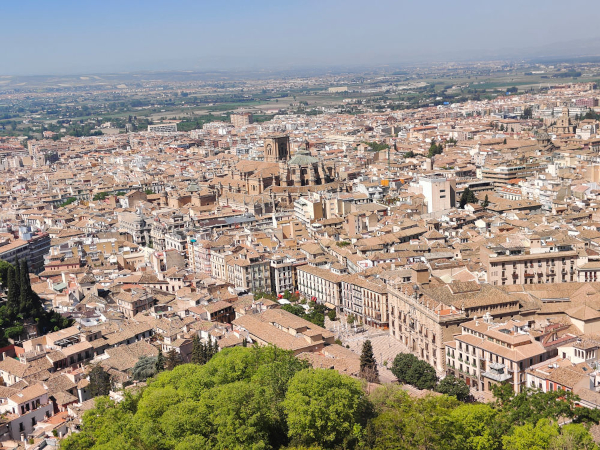
[Granada city from Torre de la Vela in Alhambra]
Granada is the capital of the eponymous province. Located at the foot of the Sierra Nevada mountains, it is at the confluence of four rivers: the Darro, Genil, Monachil and the Beiro. At 2,421 ft above sea level, it is just one hour away from the Mediterranean Sea, and slightly cooler than Seville and Cordoba. We were surprised and totally unprepared to see a snow-capped Sierra Nevada, rising high in the midst of agriculture-driven wine country.
Of course, we had planned our three days in Granada with the usual bucket list items: a planned walking tour, a visit to the fortress complex Alhambra, and a Flamenco concert. But sometimes it is the serendipitous which is just as powerful as anything one plans.
On our very first morning, as we finished a hearty Spanish Omelette for breakfast and were about to step out, we could hear the muted sounds of infectious marching band music.
When we stepped out, it felt like we’d walked into a wall of brass band music with drums—now un-muffled by the walls of the hotel. The sides of the streets were festooned with signages with crowds cheering as runners poured in. Our visit to Granada had coincided with a spring marathon complete with marching bands and celebrations all around.
We moved past the high-octane marathon to a lovely walk along the river, lined with “bitter orange” trees. It reminded me of the tree lined streets of Delhi in the 1980s, except that I had never seen trees with so much fruit in my life. The streets of Andalucia were filled with orange trees. We later learnt from Maria, one of our guides, that these are not for eating but are used in medicines, oil, perfume and as compost. We learnt how to distinguish between a bitter orange tree and a regular orange tree just by looking at the leaves—the bitter orange tree leaf has a small leaf at the base of the main leaf.

[The "bitter orange" trees]
A visit to a new place is not always about great monuments or cultural events. Some of the best travel experiences come from a spontaneous, unhurried stroll around a city—exploring the lanes and looking into shops. This beautiful stretch, full of bitter orange trees by the river, and the vibrant riverside cafes, was one such.
The highlight from Granada was a walking tour in the historic Albaicin quarter located below the Alhambra hill (with the royal Alhambra fortress). The houses along the mediaeval streets are whitewashed with lime and have small external windows (in the Islamic tradition). The narrow streets—some just about 2 feet wide—seem frozen in time and offer a perspective of the lifestyle of the common person. Just like Alhambra, the royal fortress complex looking down from above, provides a sense of the grandeur of royal life. There is a good chance that you will get lost at least once in the white labyrinth of the Albaicin.
The walk concludes at the “sunset point”, where you can laze and gaze at what unfolds before you. The view of the sunset over the Alhambra, with the snow-capped Sierra Nevada in the background, is a majestic mosaic of human and natural grandeur.
Granada city centre is a typically vibrant Western European city with lots of bars, tapas, Flamenco cuevas (which we will talk about later) and restaurants. It has beautiful functional modern buildings, great stores, and eating places. Located only a few kilometres from Albaicin, it’s like travelling in a time machine from the mediaeval ages to the 21st century.
This is also where you feel the strongest presence of the Romani (the gypsies), who are thought to have originated from India. Flamenco, which originated with the Romani, is an indelible part of Andalusian heritage. The Sacromonte hill—foothills of the Sierra Nevada, on the edge of the city—are dotted with little cave-houses where many of the Romani still live. Much of it is outside the municipal limits of Granada city. The urban issues of the outsiders, the immigrants, land encroachment are all reflected in this mishmash.
Though Sacromonte hill has now become more gentrified and boasts a number of Flamenco bars and Cuevas (Caves). Flamenco today expresses a fusion of diverse streams of cultural influence from the Romani to Jewish, Muslim and Christian. (More on Flamenco later.)
Seville
Another train ride took us to Seville. With its size and scale it is a “grander” version of Granada and a beautiful city.
Our guide on the walking tour introduced the Andalusians as people of flesh, blood and passion, punctuating his sentences with a Flamenco jump.
Interestingly, his surname was Santiago—a classically Christian name. Apparently during the clash of the civilisations, as the increasingly dominant Christians persecuted the Muslims and the Jews, the surname and the title became an increasingly important element in one’s life. His theory was Santiago was not the original family name but a title added on to convey an “authentic” Christian lineage which would protect them from persecution.
As we walked around Seville, we passed the main bullfight arena. People were arriving at the arena in horse-driven open carriages and were dressed in their formal best; the carriage drivers were dressed in traditional attire. We hadn’t planned on watching a bullfight and hadn’t bought tickets. Though bullfighting is deeply rooted in the cultural heritage of the region, we got a sense from one of our tour guides that many in Seville are conflicted about the ethics of bullfighting. A graduate in art history and now a teacher in her village, she too was vehemently against the practice.
Feria Time in Seville
Apart from the milder weather, one reason why we chose to visit in April was so we could experience the Seville April Feria or the Spring festival.
Originally a livestock fair, it has evolved into one of the biggest extravaganzas in Spain with over a million people attending.
Generally held two weeks after the Easter Holy Week, it is a week-long affair, starting from a Saturday to the following Saturday. Each day comes with its own focus and agenda. Wednesday is the most crowded as it is a public holiday; Thursday is when the politicians and celebrities throng the fair; and Friday and Saturday sees tourists from other parts of Spain. The Fair culminates on a Saturday with a grand fireworks display on the banks of the Guadalquivir river. We were able to be there only on Wednesday and Friday.
My first impression as we walked through the roads and were drawn into the epicentre of the fair was that we were being swept along a current of humanity—all walking in only one direction.
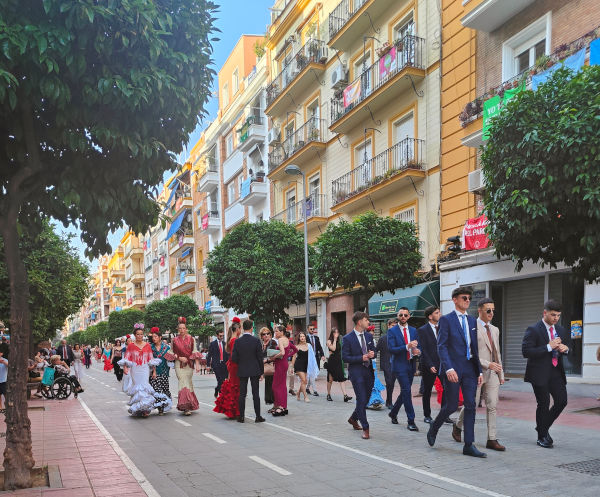
[To the Feria!]
The only pause in this flow was people stopping at a cafe where the Real Madrid versus Manchester City European Cup quarter finals was being aired.
The Feria has a series of tents where there is food, drinks and dancing; there’s spectacular lighting, special fireworks shows, and equestrian events. Women are dressed in their traditional Flamenco dresses (Flamenco is not just the music or dance, but a way of life in Andalusia) and men in their finest suits. The sight of liveried horsemen on thoroughbred Andalusian horses takes one back to the 19th century—in fact, at the Feria you need to be careful of two things: not be run over by horses and not step on their generous droppings!

[Liveried horsemen on thoroughbred Andalusian horses]
The Feria is huge, but at its heart, absolutely elitist. All but a few of the tents or Casetas are by invitation only. Business houses, universities, and rich individuals sponsor the parties at the tents and there is apparently a long queue to get the rights over a Caseta. There are just a few Casetas open to tourists, unlike say the Jerez spring fair which is open to the public. We found a tourist Caseta but were told that we needed a reservation. So we contented ourselves with gawking at the Casetas from the outside. Maybe we could have planned it better but it’s not easy for an outsider.
Having said that, it is quite an experience to see the Spanish excel at what they do best: partying, singing and Flamenco dancing to Sevilliana songs. The party goes on into the wee hours.
Cordoba
Cordoba forms the last of the Andalusian Moorish trinity after Granada and Seville. The day trip from Seville included a small stop at a charming town called Carmona with Roman ruins and whitewashed houses.
The first view of Cordoba as you gaze at the Game of Thrones-like city walls across the river, glistening in the golden Spanish sun, is breathtaking.
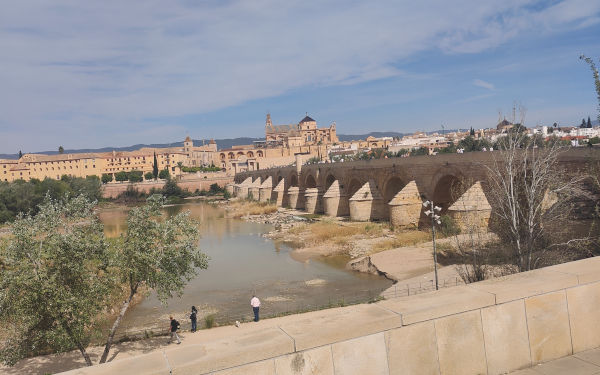
[Our first view of Cordoba]
The dominant and unique visible strand is, of course, the Moorish influence and later the great Christian cathedrals, very often built on the same sites as the mosques.
History Cast in Stone
The three centres of Seville, Cordoba and Granada form the core of Andalucia’s architectural heritage. Dominated by the unique imprint of its Muslim rulers and subsequently by the Christian responses, it offers a fascinating range of styles and visual experiences. Many of its monuments like the Alhambra at Granada, Alcazar at Seville and the Misquitta at Cordoba are designated as UNESCO World Heritage sites.
Granada is literally under the shadow of the Alhambra, located at the top of a hill. Its scale and grandeur needs to be seen to be believed. The oldest part of the Alhambra is the Alcazaba old fortress with the La Vela tower which offers gorgeous views of the City of Granada.
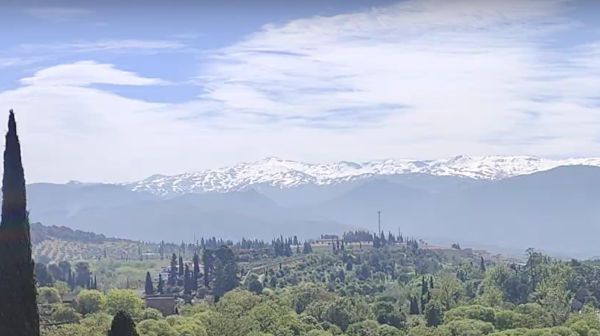
[A view of the landscape from La Vela tower]
The centrepiece of the Alhambra is the Nasrid Palace—an exquisite example of Moorish architecture with intricate geometric patterns and spacious water filled inner patios. A completely contrasting building in the same complex is the King Charles palace, a Renaissance-style building rooted in the European Christian tradition.

[Above and below: At Alhambra]
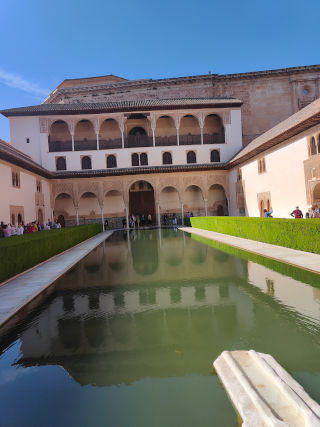
Typically, grand palaces and complexes were designed to be a show of strength and power and as successive cultures gained power, each used these majestic buildings as a show of power. What is striking in Andalusia is that the architecture of the defeated culture was mostly retained and the conqueror built either on top of the existing structure or built an entirely new edifice. It would not be strange to find a cross on top of a mosque, which creates a strange feeling when viewed with modern eyes.
The Generalife is another palace in the same complex with a spectacular set of landscaped gardens just outside the palace. Leveraging water flow and landscaping were clearly highly evolved under the Moorish rulers.
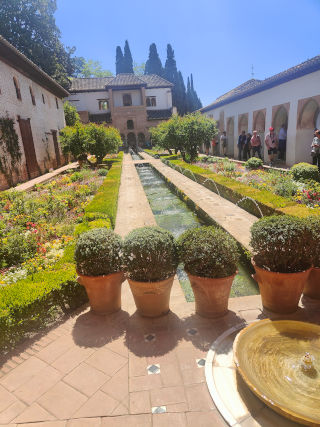
[The Generalife palace]
Seville has its share of majestic palaces and monuments with the Alcazar, Seville Cathedral and the Giralda Tower towering over the city centre. Like the Alhambra, the Alcazar is recognised as a UNESCO world heritage site. The Seville Cathedral, where Christopher Columbus is buried, is equally magnificent and the second largest cathedral in the world. Very clearly, across Andalusia, the Christian legacy being the most recent, is perhaps dominant today. But it has not prevented Andalusians from recognising and marketing their unique syncretic culture at one of the world’s most popular tourist destinations. After all Morocco and Africa are just a short one-hour ferry ride from Spain and cultural exchanges are inevitable.

[At Alcazar]
Cordoba boasts the famous Mosque Cathedral or the Mesquita. Yes, its probably the only “mosque cathedral” in the world. The architecture is of course iconic and the history of the expansion of the mosque is equally fascinating. As each caliph added a new section of the mosque to emphasise his authority and wealth, the mosque expanded to its current gargantuan proportions. One could see the differences in the approach of the Muslim rulers and finally when they were all conquered by the Christians, the differences were even more pronounced with a shift from Islamic iconography to human figures and other Christian stylistic influences. The Cathedral section is equally magnificent.
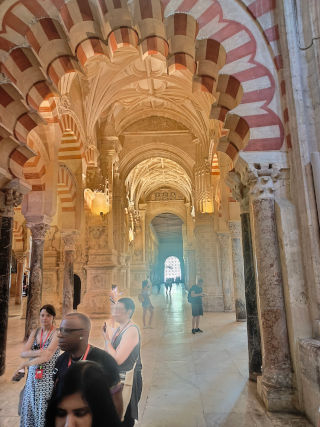
[The mosque cathedral at Cordoba]
We saw the differences in the Muslim houses, beautiful patios (houses with open inner courtyards with water fountains and streams), the Jewish quarter and more.
Flamenco & Urban Gypsies
[Street Flamenco at Seville]
Flamenco is probably one of the biggest exports of Andalusia—for the musically inclined, it is one of the most exciting musical forms. Guitarists like Paco de Lucia are legendary well beyond the traditional Andalusian audiences. But Flamenco goes well beyond the music or the dance—it is an entire culture. The traditional dresses worn by women, for instance, are also called Flamenco.
The Flamenco of each city is slightly different: We caught two performances in Seville and Granada.
An experience not to be missed is a Flamenco performance in a cave in Granada. This is where you experience Flamenco with the right Spanish “duende” or authentic emotion. Though the cave performances have become increasingly structured as one hour capsules for tourists, the raw voiced singers, the dancers in their brilliant Flamenco outfits, the intricate foot tapping rhythms, the soulful singers and guitarists—all form a unique experience.

In Seville, we caught a more formalised performance set in a tableau or theatre hall with more stylised performances. Also a very interesting experience.
Day Trips to Cadiz and Jerez
While in Seville, we had planned a day trip to the twin cities of Cadiz - Jerez. It offered us an opportunity to experience the countryside.
Jerez, part of wine country in Andalusia, is at the heart of the equestrian tradition in Andalusia with its famous riding school with spectacular performances by highly trained horses and riders. We had the misfortune of the show getting cancelled, but do try to plan a trip around that. We managed to visit a winery and tried some Jerez Sherry.
Cadiz is a classic seaside town right on the Atlantic (yes, not on the Mediterranean—remember, we are near the bottom of the Iberian Peninsula and there are different oceans on different sides of Andalusia). A lovely town with quaint marketplaces, a beautiful waterfront and charm, it makes for a great contrast.
Between fairs, Flamenco, horses, bullfighting and the grand sense of history, it’s hard to pick one standout experience in Andalusia. All in all, Andalusia offers great variety, wonderful culture, beautiful scenery and a flavour of Spain not present anywhere else. You can choose the prism through which you wish to look at Andalusia depending upon your preferences.
How to make the most of your trip
Best time to visit: Spring and Autumn are good. Avoid June to early September when temperatures can touch 40 degrees C. We chose April, as we wanted to experience the Feria at Seville.
Book group tickets in advance: Whether it’s the Alhambra at Granada or the Alcazar, it is useful to book group tickets in advance. Typically there are specialised time slots and they get sold out months in advance. Group tickets have a separate entrance and you can avoid the long queues.
Food and drink: Andalusia is known for its tapas and Iberian ham. While paella is available everywhere, it is a Valencian speciality (east coast of Spain); Andalucians don’t consider it their own.
Since this is wine country, do try the Jerez sherry.

